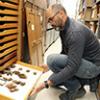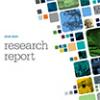Scientists know that plants emit chemicals into the soil to communicate information to other plants. These chemical messages, sent through fungal networks, may warn plants to defend against threats in their environment or to stop encroaching on another plant’s space.
Press Releases
Primary tabs
The Ohio Supercomputer Center’s (OSC) Statewide Users Group (SUG) Conference on Thursday, Oct. 7, brought researchers from around the state together virtually. Through Zoom, attendees learned about OSC’s latest services and resources and heard flash talks about research that utilizes the Center’s high performance computing (HPC) capabilities.
The conference emphasized the many ways attendees can engage with OSC beyond SUG meetings. OSC staff highlighted how researchers can make use of available services, learn more about OSC’s impact and help shape future plans.
The Ohio Supercomputer Center (OSC) will serve as a core collaborator in the new NSF AI Institute for Intelligent Cyberinfrastructure with Computational Learning in the Environment (ICICLE), one of 11 such Artificial Intelligence (AI) Research Institutes created as part of a $200 million grant announced today by the National Science Foundation (NSF).
The Ohio State University Molecular and Cellular Imaging Center (MCIC) serves as a shared technology laboratory to facilitate research in microscopy, genomics and bioinformatics. Since its founding in 2000, the center has grown into a data-intensive operation that has thrived in partnership the Ohio Supercomputer Center (OSC).
Efficiency and accuracy are everything in motorsports. Finely tuned engineering workflows must operate on demanding timelines and reliably deliver aerodynamically optimized vehicles. Automotive and industrial company D2H Advanced Technologies relies on the Ohio Supercomputer Center’s (OSC) on-demand high performance computing (HPC) for maximum efficiency in both process and product.
An election year in the United States is marked by incisive campaign ads, heated debates and get-out-the-vote messaging. The bombast of the 2020 presidential election was further amplified by the heavily politicized COVID-19 pandemic. With the help of the Ohio Supercomputer Center (OSC), The Ohio State University’s Skyler Cranmer used Twitter data to examine the extent of this partisan polarization.
Walking into a lecture hall of over 200 students can be daunting for a young undergraduate, especially when that class is centered around conducting statistical analyses of biological data. Laura Kubatko, a professor at The Ohio State University, teaches Statistics for the Life Sciences and is well aware of the apprehension that students feel.
Jane Combs, associate director of research computing services at the University of Cincinnati, wanted to increase accessibility to supercomputing resources. Through Open OnDemand, UC's own cluster is now accessible to numerous faculty, staff and students.
Ohio State University Professor Bryan Carstens spends his time researching biology and genetics and often runs across immense data sets that are hard to navigate. Carstens worked with the Ohio Supercomputer Center to build connections between databases for easier analysis and access.
The Ohio Supercomputer Center (OSC) 2019-20 Research Report is now available online. The publication highlights news from OSC and spotlights the research and education enabled by Ohio's statewide high performance computing resource.







